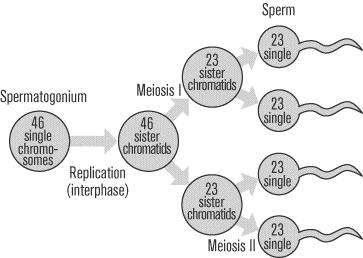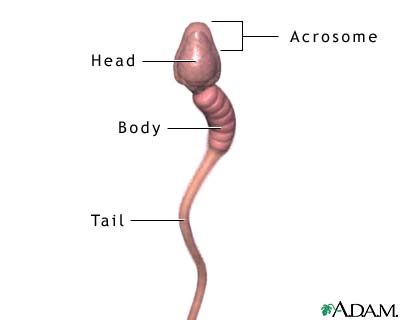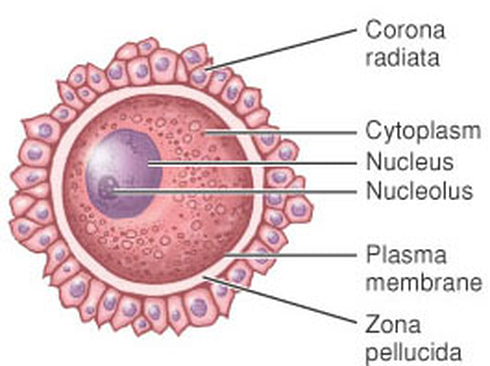Gametogenesis
Gametes are formed through a process called gametogenesis. This takes place in the gonads (testicles and ovaries). Gametes are formed by germ cells which, like all other human cells, have 46 chromosomes. During gametogenesis, the number of chromosomes is halved, through a special type of cell division called meiosis. Therefore, each gamete only has 23 chromosomes, instead of 46. When an egg and a sperm join together during fertilization to form a zygote, the total number of 46 chromosomes is restored. The new cell contains a set of
genetic material from the mother and a set from the father.
Sperm
Sperm are highly specialised cells that carry the genetic material of the male.
The formation and maturation of sperm is triggered by follicle stimulating hormone (FSH), released from the pituitary gland. The testes produce sperm continually at a rate of about 100 000 000 per day from puberty to old age.
There are around 120 million sperm in every milliliter of semen.
genetic material from the mother and a set from the father.
Sperm
Sperm are highly specialised cells that carry the genetic material of the male.
The formation and maturation of sperm is triggered by follicle stimulating hormone (FSH), released from the pituitary gland. The testes produce sperm continually at a rate of about 100 000 000 per day from puberty to old age.
There are around 120 million sperm in every milliliter of semen.
A sperm cell has three main parts: the head, the body and the tail. In the head of the sperm is the nucleus which contains chromosomes (the genetic information from the father). The body contains many mitochondria which provide energy to the tail, which makes the movement possible driving the sperm forward and allowing it to swim towards the egg. The sperm determines the sex of the future child.
Ova
Eggs or female sex cells are large round cells that, like sperm, also have 23 chromosomes. It does not move on its own, and it contains food reserve in the form of yolk to feed the zygote for the first few days after fertilisation.
The egg is covered by a complex protective layer, the zona pellucida and the corona radiata, which the sperm will have to cross in order to fertilise it.
Eggs or female sex cells are large round cells that, like sperm, also have 23 chromosomes. It does not move on its own, and it contains food reserve in the form of yolk to feed the zygote for the first few days after fertilisation.
The egg is covered by a complex protective layer, the zona pellucida and the corona radiata, which the sperm will have to cross in order to fertilise it.
References
Anon, (2015). [online] Available at: http://4.bp.blogspot.com/- [Accessed 10 May 2015].
Anon, (2015). [online] Available at:
http://U1eDEukP0fA/VJkkldS8tjI/AAAAAAAAAV8/4swpyYXpoV8/s1600/menstrual%2Bcycl e%2Bchart%2B-%2B3.jpeg [Accessed 10 May 2015].
Artificialinsemination.files.wordpress.com, (2015). [online] Available at:
https://artificialinsemination.files.wordpress.com/2011/04/ovary-schematic.jpg [Accessed 10 May 2015].
Cabrera Calero, A. & Sanz Esteban, M. (2011). Biología y geología, 3º ESO, Andalucía. San Fernando de Henares, Madrid: Oxford Educación.
Cycles, F. (2015). Follow the Female Ovarian and Menstrual Cycles - For Dummies. [online] Dummies.com. Available at: http://www.dummies.com/how-to/content/followthefemaleovarian-and-menstrual-cycles.html [Accessed 10 May 2015].
Dynamisch.nu, (2015). [online] Available at:
http://dynamisch.nu/feno/afbembryoengels/83ovary.jpg [Accessed 10 May 2015].
Healthline.com, (2015). Bulbourethral Gland (Cowper's Gland) Anatomy, Function & Diagram | Body Maps. [online] Available at: http://www.healthline.com/humanbodymaps/bulbourethralcowpers-gland [Accessed 10 May 2015].
Ibbio.pbworks.com, (2015). [online] Available at:
http://ibbio.pbworks.com/f/1317538698/oocyte.jpg [Accessed 10 May 2015].
Img.gawkerassets.com, (2015). [online] Available at:
http://img.gawkerassets.com/img/19d5bsdvffcvtpng/ku-xlarge.png [Accessed 10 May 2015].
Meritnation.com, (2016). Meritnation: The No.1 Education Site with Study Material & Live Classes for CBSE, ICSE, CPT, IITJEE, AIPMT & more. [online] Available at: http://www.meritnation.com/ [Accessed 5 Feb. 2016].
Nlm.nih.gov, (2015). Sexually Transmitted Diseases: MedlinePlus. [online] Available at:
http://www.nlm.nih.gov/medlineplus/sexuallytransmitteddiseases.html [Accessed 10 May 2015].
Passmyexams.co.uk, (2015). Components of Blood, Cardiovascular System - Pass My Exams:
Easy exam revision notes for GSCE Biology. [online] Available at:
http://www.passmyexams.co.uk/GCSE/biology/cardiovascular-system.html#1 [Accessed 4 May 2015].
Passmyexams.co.uk, (2015). The Menstrual Cycle - Pass My Exams: Easy exam revision notes for GSCE Biology. [online] Available at:
http://www.passmyexams.co.uk/GCSE/biology/menstrual-cycle-and-hormones.html [Accessed 10 May 2015].
Pearltrees.com, (2015). [online] Available at:
http://www.pearltrees.com/s/pic/or/veinsarteriescapillaries-56549509 [Accessed 4 May 2015].
Pickering, W. (2006). Complete biology for IGCSE. Oxford [England]: Oxford University Press.
Tpsbiology11student2.wikispaces.com, (2015). [online] Available at:
http://tpsbiology11student2.wikispaces.com/file/view/bloodcomponents.jpg/186793981/bloo dcomponents.jpg [Accessed 4 May 2015].
Urgo.co.uk, (2015). [online] Available at:
http://www.urgo.co.uk/uploadedfiles/img/images/venous-system-big-01.jpg [Accessed 4 May 2015].
Webmd.com, (2015). The Vagina (Human Anatomy): Picture, Parts, Function, Definition, and Problems. [online] Available at: http://www.webmd.com/women/picture-of-the-vagina [Accessed 10 May 2015].
Women-info.com, (2016). [online] Available at: http://www.women-info.com/ [Accessed 5 Feb.
2016].
Anon, (2015). [online] Available at: http://4.bp.blogspot.com/- [Accessed 10 May 2015].
Anon, (2015). [online] Available at:
http://U1eDEukP0fA/VJkkldS8tjI/AAAAAAAAAV8/4swpyYXpoV8/s1600/menstrual%2Bcycl e%2Bchart%2B-%2B3.jpeg [Accessed 10 May 2015].
Artificialinsemination.files.wordpress.com, (2015). [online] Available at:
https://artificialinsemination.files.wordpress.com/2011/04/ovary-schematic.jpg [Accessed 10 May 2015].
Cabrera Calero, A. & Sanz Esteban, M. (2011). Biología y geología, 3º ESO, Andalucía. San Fernando de Henares, Madrid: Oxford Educación.
Cycles, F. (2015). Follow the Female Ovarian and Menstrual Cycles - For Dummies. [online] Dummies.com. Available at: http://www.dummies.com/how-to/content/followthefemaleovarian-and-menstrual-cycles.html [Accessed 10 May 2015].
Dynamisch.nu, (2015). [online] Available at:
http://dynamisch.nu/feno/afbembryoengels/83ovary.jpg [Accessed 10 May 2015].
Healthline.com, (2015). Bulbourethral Gland (Cowper's Gland) Anatomy, Function & Diagram | Body Maps. [online] Available at: http://www.healthline.com/humanbodymaps/bulbourethralcowpers-gland [Accessed 10 May 2015].
Ibbio.pbworks.com, (2015). [online] Available at:
http://ibbio.pbworks.com/f/1317538698/oocyte.jpg [Accessed 10 May 2015].
Img.gawkerassets.com, (2015). [online] Available at:
http://img.gawkerassets.com/img/19d5bsdvffcvtpng/ku-xlarge.png [Accessed 10 May 2015].
Meritnation.com, (2016). Meritnation: The No.1 Education Site with Study Material & Live Classes for CBSE, ICSE, CPT, IITJEE, AIPMT & more. [online] Available at: http://www.meritnation.com/ [Accessed 5 Feb. 2016].
Nlm.nih.gov, (2015). Sexually Transmitted Diseases: MedlinePlus. [online] Available at:
http://www.nlm.nih.gov/medlineplus/sexuallytransmitteddiseases.html [Accessed 10 May 2015].
Passmyexams.co.uk, (2015). Components of Blood, Cardiovascular System - Pass My Exams:
Easy exam revision notes for GSCE Biology. [online] Available at:
http://www.passmyexams.co.uk/GCSE/biology/cardiovascular-system.html#1 [Accessed 4 May 2015].
Passmyexams.co.uk, (2015). The Menstrual Cycle - Pass My Exams: Easy exam revision notes for GSCE Biology. [online] Available at:
http://www.passmyexams.co.uk/GCSE/biology/menstrual-cycle-and-hormones.html [Accessed 10 May 2015].
Pearltrees.com, (2015). [online] Available at:
http://www.pearltrees.com/s/pic/or/veinsarteriescapillaries-56549509 [Accessed 4 May 2015].
Pickering, W. (2006). Complete biology for IGCSE. Oxford [England]: Oxford University Press.
Tpsbiology11student2.wikispaces.com, (2015). [online] Available at:
http://tpsbiology11student2.wikispaces.com/file/view/bloodcomponents.jpg/186793981/bloo dcomponents.jpg [Accessed 4 May 2015].
Urgo.co.uk, (2015). [online] Available at:
http://www.urgo.co.uk/uploadedfiles/img/images/venous-system-big-01.jpg [Accessed 4 May 2015].
Webmd.com, (2015). The Vagina (Human Anatomy): Picture, Parts, Function, Definition, and Problems. [online] Available at: http://www.webmd.com/women/picture-of-the-vagina [Accessed 10 May 2015].
Women-info.com, (2016). [online] Available at: http://www.women-info.com/ [Accessed 5 Feb.
2016].




